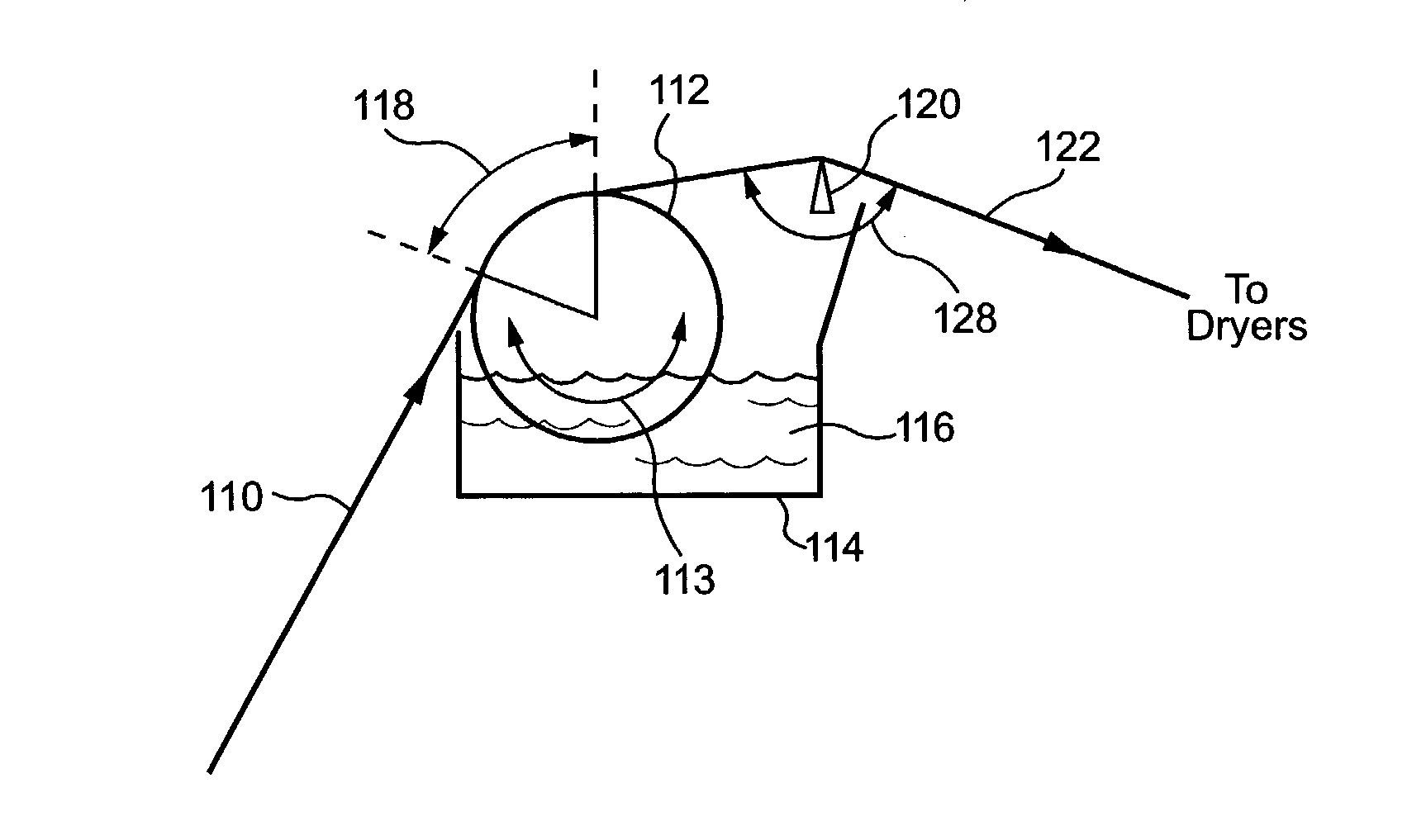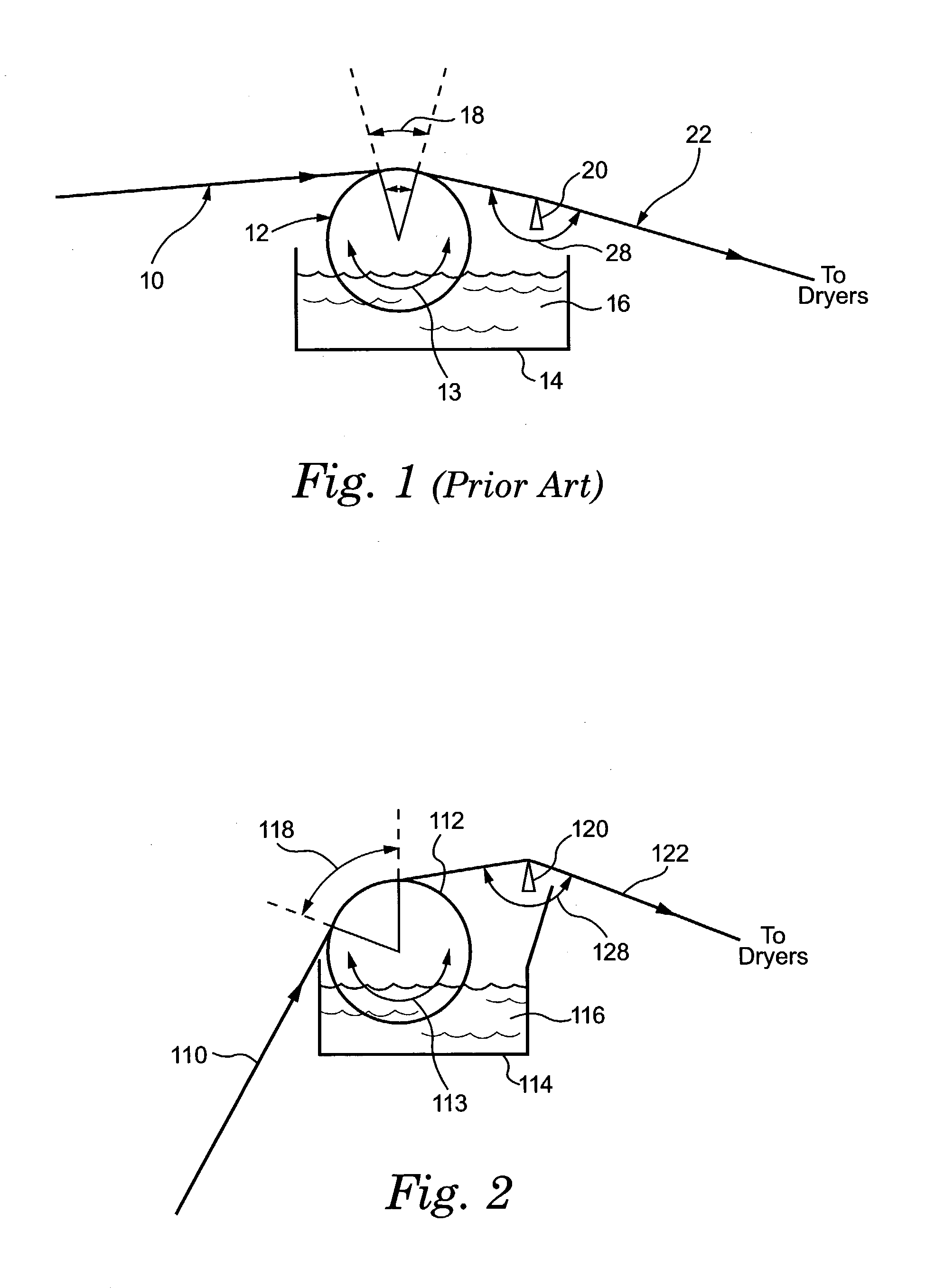Method and composition for coating mat and articles produced therewith
a technology of coating mats and compositions, which is applied in the field of methods and compositions for coating mats and articles produced therewith, can solve the problems of affecting the cohesion strength of glass mats is typically too low to resist the pulling-away force of high-wind shear vacuums, and the application of gypsum boards is more difficult, so as to achieve a higher degree of uniform coating penetration
- Summary
- Abstract
- Description
- Claims
- Application Information
AI Technical Summary
Benefits of technology
Problems solved by technology
Method used
Image
Examples
example 2 (
PRIOR ART)
[0056] As Example 2, a coated glass mat facer fabricated by Elk Corporation in accordance with the prior art process of U.S. Pat. No. 5,965,257 and known as "ISO FACER 1" was evaluated. The coated glass mat facer of Example 2 weighed about 99-lbs / MSF, and measured (with a caliper) a thickness of about 0.034-inches. Thirty samples of tensile test data for the mat of Example 2 are shown in Table 2, the first column of Table 2 showing tensile test data with respect to the machine direction (M.D.) and the second column showing tensile test data with respect to the cross-machine direction (C.M.D.).
[0057] Comparison of the tensile strengths for Example 1 and Example 2 as set forth in Table 1 and Table 2, respectively, show that even with more thickness and higher weight, the product of Example 2 is considerably weaker than the product made as Example 1. Yet both Example 1 and Example 2 pale in contrast to the substantially higher tensile strengths achieved by the remaining Examp...
example 3
[0059] Example 3 utilized the same coating batch mixture as Example 1. The coating of Example 3 was applied to a glass mat using the process of FIG. 2. The glass mat weighed 14.5-pounds per MSF (thousand square feet).
[0060] Table 3 shows samples of tensile strength data for Example 3. As with the Table 4 mats discussed subsequently, for the Table 3 mats the sample size tested was 3-inches wide by 10-inches long, with 1-inch at each end inside the jaws, and the tensile test jaws were pulled at the speed of 1-inch per minute. The coated glass mats of Example 3 had an average thickness of 0.026-inches and weighed an average of 85-lbs per 1,000-square feet (MSF). Of that finished weight, about 70.5-lbs / MSF was coating and 14.5-lbs / MSF was glass mat.
4TABLE 3 Sample # Machine Direction Cross Mach. Dir. 1 101.6-lbs / 3-inch 114.1-lbs / 3-inch 2 113.5-lbs / 3-inch 111.8-lbs / 3-inch 3 140.2-lbs / 3-inch 113.1-lbs / 3-inch 4 116.9-lbs / 3-inch 102.9-lbs / 3-inch 5 120.5-lbs / 3-inch 95.5-lbs / 3-inch 6 110.9-lb...
example 4
[0063] The coating batch for Example 4 was the same as for Example 1, but was applied using the process of FIG. 2 to a glass mat (Dura-Glass 7503) sold as weighing 14.5-pounds per MSF (thousand square feet), but actually weighing 14.9-pounds per MSF. The coated glass mat weighed 89.1-pounds per MSF on average. As with the Example 1 mats, the Example 4 mat sample size tested was 3-inches wide by 10-inches long, with 1-inch at each end inside the jaws, and the tensile test jaws were pulled at the speed of 1-inch per minute. Approximately the same coating weight was applied (an average of 74.2-pounds / MSF), but the improved processing techniques made the coating penetrate more uniformly and further into the glass mat substrate. In doing this, the approximate same coating weight created a final product with substantially higher tensile strength, as indicated by Table 4.
5 TABLE 4 Example 4 Tensile Data Sample # M.D. C.M.D. 1 122 110 2 114 108 3 141 113 4 117 103 5 121 96 6 123 120 7 112 1...
PUM
| Property | Measurement | Unit |
|---|---|---|
| wrap angle | aaaaa | aaaaa |
| wrap angle | aaaaa | aaaaa |
| wrap angle | aaaaa | aaaaa |
Abstract
Description
Claims
Application Information
 Login to View More
Login to View More - R&D
- Intellectual Property
- Life Sciences
- Materials
- Tech Scout
- Unparalleled Data Quality
- Higher Quality Content
- 60% Fewer Hallucinations
Browse by: Latest US Patents, China's latest patents, Technical Efficacy Thesaurus, Application Domain, Technology Topic, Popular Technical Reports.
© 2025 PatSnap. All rights reserved.Legal|Privacy policy|Modern Slavery Act Transparency Statement|Sitemap|About US| Contact US: help@patsnap.com



